2009 marks the 100th anniversary of Seattle's Alaska-Yukon-Pacific Exposition and plans are already afoot for the new year.
There are two sites info about 2009's plans:
http://www.AYP100.org/ and http://www.AYPE.org/
30 December 2008
09 December 2008
Expo 2010 United States Pavilion Press Release
"US Must Act Rapidly to Ensure Participation in China's 2010 World Expo or Risk Major Diplomatic Blunder, Says Consortium"
That's the headline of a press release today from the BH&L Group, of which I'm a member of its advisory board. We're hoping to save the troubled efforts to create a United States Pavilion at Shanghai's Expo 2010, China's first world's fair.
To that end, I created the website UnitedStatesPavilion.com. I'm hoping this might finally get the ball rolling.
The press release can be found at: http://www.prweb.com/releases/2008/12/prweb1702724.htm.
That's the headline of a press release today from the BH&L Group, of which I'm a member of its advisory board. We're hoping to save the troubled efforts to create a United States Pavilion at Shanghai's Expo 2010, China's first world's fair.
To that end, I created the website UnitedStatesPavilion.com. I'm hoping this might finally get the ball rolling.
The press release can be found at: http://www.prweb.com/releases/2008/12/prweb1702724.htm.
27 October 2008
Sad News about the Expo 2010 United States Pavilion
I've received word tonight that the group that the State Department had chosen to fund, plan, design, build, and staff a United States Pavilion at Expo 2010, has announced that they've run out of both time and money.
Expo 2010 opens in May 2010 and it was estimated that the cost of a US Pavilion would have been about 100 million dollars. Under current government rules, all of that money would have had to have come from private industry.
It now looks like there will be no United States Pavilion at history's largest world's fair, a world's fair in perhaps the most important country of the 21st country, an exposition that will host over 200 other countries and 70 to 100 million visitors.
We need to change United States policy toward international expositions. Not only do we need to be able to fund pavilions for government monies, we need to rejoin the Bureau International des Expositions, an organization that now boasts over 100 member nations.
Expo 2010 opens in May 2010 and it was estimated that the cost of a US Pavilion would have been about 100 million dollars. Under current government rules, all of that money would have had to have come from private industry.
It now looks like there will be no United States Pavilion at history's largest world's fair, a world's fair in perhaps the most important country of the 21st country, an exposition that will host over 200 other countries and 70 to 100 million visitors.
We need to change United States policy toward international expositions. Not only do we need to be able to fund pavilions for government monies, we need to rejoin the Bureau International des Expositions, an organization that now boasts over 100 member nations.
Labels:
China,
Expo 2010,
Shanghai,
United States Pavilion
23 October 2008
Nicholas Kristof Article in New York Times
An interesting article by Nicholas Kristof appeared in today's New York Times. Entitled "Rebranding the U.S. with Obama," he talks about how public opinion of the United States will undergo a big change if Barack Obama is elected president of the United States. It includes this fascinating interchange between Mr. Kristof and a Chinese friend about Barack Obama's likely win:
Setting aside the political aspect of the article, I think it serves to illustrate how people's attitudes about a country can be changed with simple information.
Imagine the potential of a United States Pavilion at Expo 2010 in Shanghai. There's so much opportunity there, not just economically but also diplomatically. I would love to be working in the United States Pavilion and overhear Chinese people leaving the pavilion saying "What an amazing country!"
Now, imagine that there's no United States Pavilion because the funds couldn't be found. Expo 2010 will host over 200 countries for six months in Shanghai. They're expecting 70 to 100 million visitors. What will the Chinese people think if the richest and most powerful country in the world couldn't find the money to participate in China's first world's fair.
She: Obama? But he’s the black man, isn’t he?
Me: Yes, exactly.
She: But surely a black man couldn’t become president of the United States?
Me: It looks as if he’ll be elected.
She: But president? That’s such an important job! In America, I thought blacks were janitors and laborers.
Me: No, blacks have all kinds of jobs.
She: What do white people think about that, about getting a black president? Are they upset? Are they angry?
Me: No, of course not! If Obama is elected, it’ll be because white people voted for him.
[Long pause.]
She: Really? Unbelievable! What an amazing country!
Setting aside the political aspect of the article, I think it serves to illustrate how people's attitudes about a country can be changed with simple information.
Imagine the potential of a United States Pavilion at Expo 2010 in Shanghai. There's so much opportunity there, not just economically but also diplomatically. I would love to be working in the United States Pavilion and overhear Chinese people leaving the pavilion saying "What an amazing country!"
Now, imagine that there's no United States Pavilion because the funds couldn't be found. Expo 2010 will host over 200 countries for six months in Shanghai. They're expecting 70 to 100 million visitors. What will the Chinese people think if the richest and most powerful country in the world couldn't find the money to participate in China's first world's fair.
15 October 2008
NBA and AEG at Expo 2010
From the Los Angeles Times today:
http://www.latimes.com/business/la-fi-china15-2008oct15,0,7372063.story?track=rss
Unfortunately, there doesn't seem to be any new news about plans for a United States Pavilion at the site.
SHANGHAI -- The NBA and the Los Angeles sports and entertainment firm AEG announced plans Tuesday to help develop a $280-million arena and recreation center for the Shanghai World Expo in 2010 -- the first of a dozen multipurpose arenas that the new joint venture hopes to build in China.
http://www.latimes.com/business/la-fi-china15-2008oct15,0,7372063.story?track=rss
Unfortunately, there doesn't seem to be any new news about plans for a United States Pavilion at the site.
Labels:
China,
Expo 2010,
Shanghai,
United States Pavilion
25 September 2008
Tent of Tomorrow
Whenever I go to New York, I make a pilgrimage to Flushing Meadows, the site of both the 1939-'40 and 1964-'65 New York World's Fair. I try to imagine what it would have been like to have attended those expositions. The New York State Pavilion from the '64-'65 expo, even then, was in sad state of affairs. Earlier this year, they ripped out the exterior elevators to the observation saucers for fear that they would fall off.
As posted in the Queens Chronicle:
In an about-face, the city is now seeking state landmarking for the decaying 44-year-old New York State Pavilion in Flushing Meadows Park.
Although it was the city that abetted the pavilion’s neglect, Parks Department officials now say they are encouraging state landmarking — which would lead to federal status — to secure funding to restore the structure built for the 1964-65 World’s Fair.
Officials say a National Register of Historic Places listing would make the city eligible for money to shore up and restore the site.
As posted in the Queens Chronicle:
In an about-face, the city is now seeking state landmarking for the decaying 44-year-old New York State Pavilion in Flushing Meadows Park.
Although it was the city that abetted the pavilion’s neglect, Parks Department officials now say they are encouraging state landmarking — which would lead to federal status — to secure funding to restore the structure built for the 1964-65 World’s Fair.
Officials say a National Register of Historic Places listing would make the city eligible for money to shore up and restore the site.
23 September 2008
Expo 2008, Aragon Pavilion
I've posted before about the wonderful Aragon Pavilion at Expo 2008, but this past week, I discovered that the pavilion's movie, Simfonía de Aragón, had posted online.
To put the film in context, it was shown on multiple screens in a huge room that took up an entire level of the pavilion. large glossy black irregular shapes, which served as support for the pavilion divided up the interior space, which was further articulated by little streams bordered by rocks. Visitors explored the space and navigated over the stream using small bridges and discovered a few hidden artifacts in recesses in the columns. In addition to the film that dominated the space, interactive projections also provided diversions on the floor.
Here are three photos of the Aragon Paviion I took while there:
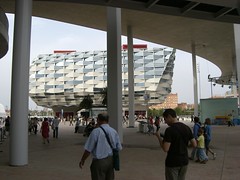
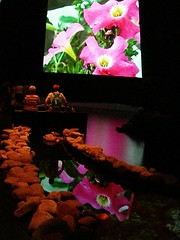
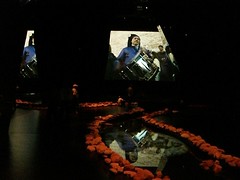
Here is the film in two parts:
To put the film in context, it was shown on multiple screens in a huge room that took up an entire level of the pavilion. large glossy black irregular shapes, which served as support for the pavilion divided up the interior space, which was further articulated by little streams bordered by rocks. Visitors explored the space and navigated over the stream using small bridges and discovered a few hidden artifacts in recesses in the columns. In addition to the film that dominated the space, interactive projections also provided diversions on the floor.
Here are three photos of the Aragon Paviion I took while there:



Here is the film in two parts:
Labels:
Aragon,
Aragon Pavilion,
Expo 2008,
world's fair,
Zaragoza
20 September 2008
Expo 2008, Closing Day
Sadly, I was not at Expo 2008 for closing day. But, by all reports, it was pretty amazing. Thankfully, we live in the age of YouTube. A kind soul posted the closing ceremonies performance by Philip Glass (incidentally, my favorite composer), who also performed at Seville's Expo '92.
Expo 2008, being a relatively small world's fair, and Zaragoza, being a relatively small city, made for an amazing atmosphere. I can't recall a city being and an expo being so integrated into each other. The Expo seemed to start way outside the gates. The videos from the closing ceremonies show that. The fireworks running up and down the Ebro River connected the Expo site to the historic center of town. Like many visitors to Expo, my hotel was there, so I had the pleasure of walking to and from the world's fair site alongside the river.
Apparently, Expo 2008 had 5.65 million visitors, just shy of their projected 6 million. Interestingly, they overbuilt their parking facilities. They were mostly empty when I visited in June and apparently went mostly unused with 40.1% taking buses to the site and an amazing 18.5% traveling by foot! It's a wonderfully walkable city and I hope to visit someday in the future and see how the expo site is woven into the fabric of the city.
Here's Aragon TV's coverage (in 5 parts), including a great round-up video at the end:
Expo 2008, being a relatively small world's fair, and Zaragoza, being a relatively small city, made for an amazing atmosphere. I can't recall a city being and an expo being so integrated into each other. The Expo seemed to start way outside the gates. The videos from the closing ceremonies show that. The fireworks running up and down the Ebro River connected the Expo site to the historic center of town. Like many visitors to Expo, my hotel was there, so I had the pleasure of walking to and from the world's fair site alongside the river.
Apparently, Expo 2008 had 5.65 million visitors, just shy of their projected 6 million. Interestingly, they overbuilt their parking facilities. They were mostly empty when I visited in June and apparently went mostly unused with 40.1% taking buses to the site and an amazing 18.5% traveling by foot! It's a wonderfully walkable city and I hope to visit someday in the future and see how the expo site is woven into the fabric of the city.
Here's Aragon TV's coverage (in 5 parts), including a great round-up video at the end:
Labels:
closing ceremonies,
Expo 2008,
Expo 92,
Philip Glass,
Spain,
Zaragoza
12 September 2008
Edmonton Sun: 2017 World's Fair 'Doable' for Edmonton
In today's Edmonton Sun:
Bringing the world's fair to the Alberta capital in 2017 is "doable," say officials laying the groundwork for Edmonton's bid.
http://cnews.canoe.ca/CNEWS/Canada/2008/09/12/6744116-sun.html
I've said it before, but I'll say it again: I would be very happy to finally see a world's fair in North America again. If 2017 is the year, it will end a 31 year gap in North American world's fairs. The last expo was Expo '86 in Vancouver.
Bringing the world's fair to the Alberta capital in 2017 is "doable," say officials laying the groundwork for Edmonton's bid.
http://cnews.canoe.ca/CNEWS/Canada/2008/09/12/6744116-sun.html
I've said it before, but I'll say it again: I would be very happy to finally see a world's fair in North America again. If 2017 is the year, it will end a 31 year gap in North American world's fairs. The last expo was Expo '86 in Vancouver.
Labels:
Alberta,
Edmonton,
Expo 2017,
Expo 86,
world's fair
10 September 2008
Expo 2008 Attendance Numbers
I still haven't found a cumulative number for Expo 2008's attendance yet, but the BIE is reporting that the average attendance at Expo 2008 as of 09 September is 57,909. Not surprisingly, yesterday's attendance was higher than that: 89,441.
http://www.bie-paris.org/main/popup.php?a=620
I say it isn't surprising since we're in the last week. When I went to Expo 2005, I was there the last ten days and I can attest that there's always a huge surge of visitors during the last few days. People have unused tickets and many locals want to see the Expo before it closes. After all, there's no second season.
So, since yesterday was the 88th of the 93 days, we can assume they've had about 5,095,992 visitors (88 x 57,909). If we assume the next five days will also have high attendance (and I think we could argue the last two days, a weekend, will be even higher), that would add at least 447,205 more visitors (5 x 89,441) to make the total 5,543,197.
Before Expo 2008 started, they predicted 6,000,000 visitors. To meet that, they'd need 904,008 visitors in the next five days, an average of 180,801 per day.
http://www.bie-paris.org/main/popup.php?a=620
I say it isn't surprising since we're in the last week. When I went to Expo 2005, I was there the last ten days and I can attest that there's always a huge surge of visitors during the last few days. People have unused tickets and many locals want to see the Expo before it closes. After all, there's no second season.
So, since yesterday was the 88th of the 93 days, we can assume they've had about 5,095,992 visitors (88 x 57,909). If we assume the next five days will also have high attendance (and I think we could argue the last two days, a weekend, will be even higher), that would add at least 447,205 more visitors (5 x 89,441) to make the total 5,543,197.
Before Expo 2008 started, they predicted 6,000,000 visitors. To meet that, they'd need 904,008 visitors in the next five days, an average of 180,801 per day.
04 September 2008
Visiting the Season Pass Podcast
This week I had the great pleasure to visit the folks at the Season Pass Podcast and talk world's fairs. It's now available to listen to at:
http://seasonpasspodcast.libsyn.com/index.php?post_id=374642
We also talked a bit about Atlanta's World of Sid and Marty Krofft amusement park that lasted just one season in 1976.
http://seasonpasspodcast.libsyn.com/index.php?post_id=374642
We also talked a bit about Atlanta's World of Sid and Marty Krofft amusement park that lasted just one season in 1976.
19 August 2008
Random World's Fair News Notes
I've run across several world's fair stories recently.
Various American Cities 1933-1940:
The National Building Museum will host an exhibit entitled "Designing Tomorrow: America’s World’s Fairs of the 1930s." It opens in October 2009.
New York 1939-1940:
The New York Times has an interesting article about a bomb that killed two city detectives in the British Pavilion. The case remains unsolved.
Seattle 1962:
The monorail from Seattle's 1962 Century 21 Exposition will soon be returned to its original condition.
New York 1964-1965:
I had no idea that pita bread was introduce to the United States at the 1964-'65 New York World's Fair.
Spokane 1974:
The Seattle Times writes about Spokane's Riverfront Park, legacy site of Expo 74.
Man Belongs to the Earth, a film from the United States Pavilion is available on YouTube. It's an early example of environmentalist messaging from the first world's fair with an environmental theme.
Shanghai 2010:
France has set up it's Expo 2010 pavilion web site .
(Unknown) 2020:
Copenhagen might bid for Expo 2020.
The Gotthard Region of Switzerland might also bid for Expo 2020.
Various American Cities 1933-1940:
The National Building Museum will host an exhibit entitled "Designing Tomorrow: America’s World’s Fairs of the 1930s." It opens in October 2009.
New York 1939-1940:
The New York Times has an interesting article about a bomb that killed two city detectives in the British Pavilion. The case remains unsolved.
Seattle 1962:
The monorail from Seattle's 1962 Century 21 Exposition will soon be returned to its original condition.
New York 1964-1965:
I had no idea that pita bread was introduce to the United States at the 1964-'65 New York World's Fair.
Spokane 1974:
The Seattle Times writes about Spokane's Riverfront Park, legacy site of Expo 74.
Man Belongs to the Earth, a film from the United States Pavilion is available on YouTube. It's an early example of environmentalist messaging from the first world's fair with an environmental theme.
Shanghai 2010:
France has set up it's Expo 2010 pavilion web site .
(Unknown) 2020:
Copenhagen might bid for Expo 2020.
The Gotthard Region of Switzerland might also bid for Expo 2020.
06 August 2008
Expo 2008 Review on Blooloop.com
Blooloop.com, an amusement/theme park industry web site, has just published an article I've written about Expo 2008.
Labels:
Blooloop.com,
Expo 2008,
review,
Spain,
Zaragoza
16 July 2008
Antalya, Turkey to Bid for Expo 2017 or Expo 2023
On the heels of Izmir, Turkey's losing bid for the large BIE-sanctioned Expo 2015, the city of Antalya, Turkey has announced that it will bid for the smaller BIE-recognized Expo 2017 or Expo 2023.
More news about this bid at TurkishPress.com
More news about this bid at TurkishPress.com
10 July 2008
Expo 2008, Iceberg
Reading over my posts from my Expo 2008 visit and going through the 1200+ photos I took during those six days, I'm realizing there are noteworthy exhibits and performances I either didn't mention or didn't elaborate on.
The Iceberg performance is certainly one of these. The night before my first day on the site, we walked along the Ebro River toward the site and we were surprised by how much of Iceberg was visible from outside the gates. There was also a spectacular fireworks display afterwards.
I think this element of Expo 2008 will be one of the ones that folks in Zaragoza will remember decades from now when reminiscing about the expo. It's made even more powerful in that it is set on the opposite side of the river from the Expo site and the audience.
Unfortunately, my own video of Iceberg wasn't of a great quality. Lucky for us, others have posted on YouTube their own recordings. The best of these recordings I'm embedding here. It's in three parts.
The Iceberg performance is certainly one of these. The night before my first day on the site, we walked along the Ebro River toward the site and we were surprised by how much of Iceberg was visible from outside the gates. There was also a spectacular fireworks display afterwards.
I think this element of Expo 2008 will be one of the ones that folks in Zaragoza will remember decades from now when reminiscing about the expo. It's made even more powerful in that it is set on the opposite side of the river from the Expo site and the audience.
Unfortunately, my own video of Iceberg wasn't of a great quality. Lucky for us, others have posted on YouTube their own recordings. The best of these recordings I'm embedding here. It's in three parts.
30 June 2008
Expo 2008, Day 6
My final day of Expo I spent visiting my favorite pavilions and taking more photos and video.
I made sure to return to the Germany Pavilion and take this (rather poor quality) video of its ride:
I also captured this video outside the Japan Pavilion which shows the Expo 2008 mascot Fluvi with the Expo 2005 mascots Kiccoro and Morizzo:
I made sure to return to the Germany Pavilion and take this (rather poor quality) video of its ride:
I also captured this video outside the Japan Pavilion which shows the Expo 2008 mascot Fluvi with the Expo 2005 mascots Kiccoro and Morizzo:
28 June 2008
Expo 2008, Day 5
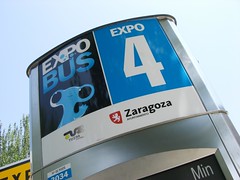
On my fifth day on the Expo 2008 site, I finally got a chance to see the Aragon Pavilion, the Spain Pavilion, and the Aquarium, meaning I finally saw every open pavilion.
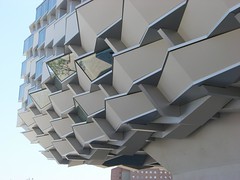
The Aragon Pavilion was designed to reference a fruit basket, one of the signature products of this region of Spain.

The exhibit ended in a large dark room with multiple screens showing the same images. It was an amazing experience to be in this space with other guests exploring the space that included pools of running water and a few artistic exhibits. My photos do not do the space justice, alas.

I finally got to see the parade through the grounds performed by Canada's Cirque du Soleil.

Spain's pavilion was, not surprisingly, difficult to get into.It starts with a domed Imax-style movie that was pretty amazing and continues through rather well designed exhibits. One room of exhibits was filled with those little plastic (blue) balls that you see in kids' play areas. There were signs advising guests to shuffle their feet to get through the area, but the exhibit area itself was roped off and we were detoured around it. I suspect it was a better idea in concept than in practice. I can imagine lots of people tripping and balls rolling into subsequent exhibit areas. Unfortunately, I was told not to photograph this exhibit, so I'll have to leave it to your imagination.

Expo 2008's aquarium is themed around the rivers of the world.
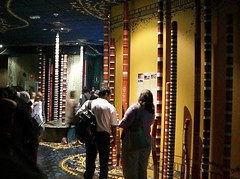
The Murray-Darling River section was particularly well themed and was a colorful reminder that you were looking at Australian wildlife.
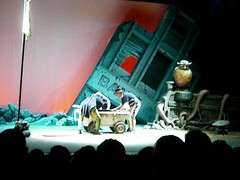
Many guests who don't speak Spanish may shy away from the performances, but I saw completely charmed by the Mondomono performance which relied mostly on visual humor to get its point across.
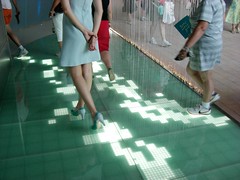
After finally seeing every exhibit, I took the time to revisit some of my favorite exhibits and take note of some of the details, such as this interactive floor in the Valencia Pavilion.
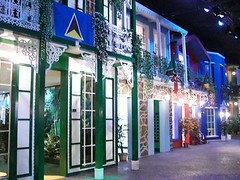
The Caribbean nations were grouped together in a wonderful space that brought what could have been conflicting exhibits into a cohesive, enjoyable space.
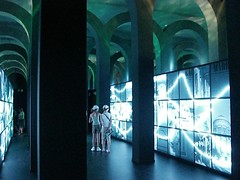
Madrid's small pavilion made clever use of mirrors to make their exhibit seem much larger than it really was.

In the evening, I enjoyed the performance Hombre Vertiente.
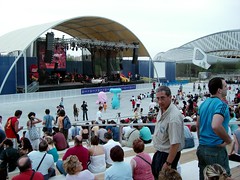
Expositions can be rather insular places where the outside world doesn't intercede much, but during the European Cup, it's difficult to ignore when the Russian Pavilion closes early so that employees can watch Spain play Russia broadcast in the Expo's amphitheatre. I noticed that Expo 2008's mascot Fluvi didn't take sides when presented a Spanish flag. After all, expos are a celebration of internationalism.
27 June 2008
Expo 2008, Day 4
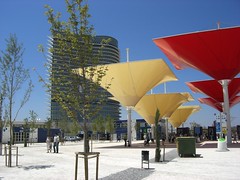
On Day 4, I finally got a chance to see the Tower of Water, the theme structure for Expo 2008. I have to admit that early on I had my reservations about this structure. It seemed like a rather large structure with such little content and at first glance, it looks like many office towers around the world. The main exception is that the outside horizontal lines are actually a slow spiral up and down the skin of the building.
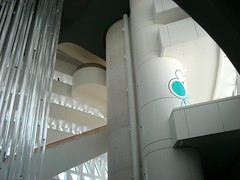
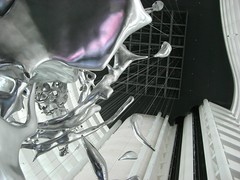
Visiting the tower, I'm afraid that my concerns were founded. With the exception of a few exhibits about water on the lowest level, the pavilion consists of two pieces of artwork that would make for a very impressive hotel lobby and lots of ramps.
Taking the escalator up a few stories, you see a rather amazing piece of artwork representing a splash of water.

Afterwards, however, you have a choice to go back down to the ground level through the (plain white) ramps just inside the skin of the building, which is tedious and takes several minutes... or you have this choice:
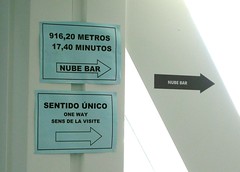
...which takes you to the upstairs Cloud (Nube) Bar... almost a kilometer walk up several stories of ramps. Elevators were reserved for the handicapped, so I chose the option to leave.
I have to wonder what amazing, iconic structure could have been built with the same resources. I think about the Eiffel Tower, the Trylon and Perisphere, and the Space Needle... all of which captured the public's imagination in the lead up to the exposition. I'm afraid this structure just seems too businesslike and unfriendly.

On the materials front, I have to make mention of an interesting material I saw being used with gravel. It gives you a surprisingly springy step despite walking on gravel and presumably, also keeps gravel from being kicked around the site.

The exhibits by African countries in recent expositions have seemed a bit chaotic and claustrophobic as dozens of countries vie for attention in a limited space. This year, however, I'm happy to report an ingenious solution to the problem.
Countries are given more generous pacing and thick short walls separate the exhibits. It has the positive effect of both opening up the space and reducing visual clutter. It also means that turning every corner provides a potential visual surprise.
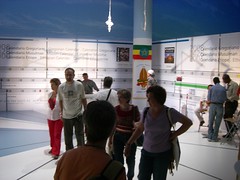
One such visual surprise was the Ethopian exhibit which celebrate the Ethiopian year 2000 (2008 in the Western Calendar) with a visual diagram of the year... radiating from the center of the exhibition space. Many pavilions suffer from repetitive panels with photos and text. I noticed that guests lingered far more in this space than other spaces with a more linear narrative.
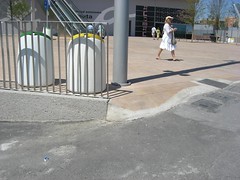
Expositions, naturally, have set dates and therefore suffer from a rush beforehand to finish everything by the opening date. I noticed a few areas where it was clear that some of the details hadn't quite been ironed out. It's a shame that some of these details weren't more artfully constructed.

The big surprise of my day was the Extreme Water ("Agua Extrema") Pavilion. It's always a joy to enter an exhibit not knowing what's inside and discover something fun and different. After visitors file past info-laden panels, they're given a rain ponch to wear for the theater presentation, a movie about heavy storms, hurricanes, and tsunamis that would leave you wet if not for the protective gear.
25 June 2008
Expo 2008, Day 3
On Day 3, I visited a few more national pavilions, the rest of the Spanish regional pavilions, and some of the theme pavilions.

I tried to visit the theme structure, the Water Tower (or Tower of Water), but unfortunately, it was closed for some reason. Unfortunately, my Spanish and the volunteers' English wasn't good enough to find out why. They suggested I try back later on. The tower was particularly striking at sunset, however.
To my eyes, though, I would have liked to have seen something a bit more iconic. The tower, from the outside at least, looks too much like many office towers I've seen.
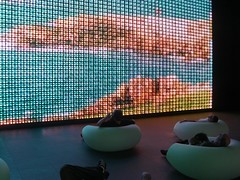
Galicia's pavilion was a good example of a small, simple pavilion that really works. There wasn't much to their exhibit as it was one where people simply wandered in and out, but the video installation was striking enough that I noticed many guests lingered for quite a while. It was more artistic and abstract that a simple video screen. Upon further inspection, I discovered each colored rectangle was actually the bottom of a plastic food dish filled with water and with red, green, and blue LED's inside. I took some more photos as well as video of this exhibit which I'll be posting later.
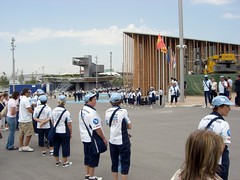
It was the Spain National Day of Honor at the site, so the Spanish Pavilion was closed. Presumably this was because of dignitaries. The site is certainly not lacking for volunteers in their iconic outfits.
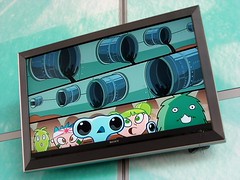
Fans of Expo 2005's Kiccoro and Morizzo will be happy to see them teamed up with Expo 2008's Fluvi outside the Japan Pavilion.
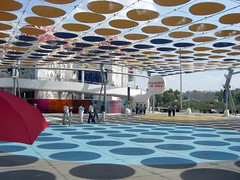
The themed areas were connected with this wonderful sunshade that seemed to visually pull together the disparate pavilions. There were plenty of nice benches, too. However, it would have been nice if they'd put the benches under the shade.
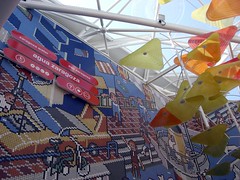
The Cities of Water Pavilion proves that you don't necessarily need new technology to create an effective exhibit. I'll speak later of the Water theme, but this pavilion exposed some of the problems with water as a theme. The issues are far more complex than can really be dealt in pavilions such as this and some of the inconsistencies are mostly unaddressed. Dams can convert water into power lessening our dependence on oil, but it can create other environmental problems.

Ten years ago at Lisbon's Expo 98, I noticed that many pavilions were using class floors so that you seemingly hovered over sand, water, or other materials. It seems like a common design choice this year is a white plastic flooring that I would imagine holds up to traffic pretty well and is certainly different from what you see in everyday life. Here's how it looked at the Sweden Pavilion. Carpet is harder to photograph than you might imagine.
...and now I'm off to Day 4!

I tried to visit the theme structure, the Water Tower (or Tower of Water), but unfortunately, it was closed for some reason. Unfortunately, my Spanish and the volunteers' English wasn't good enough to find out why. They suggested I try back later on. The tower was particularly striking at sunset, however.
To my eyes, though, I would have liked to have seen something a bit more iconic. The tower, from the outside at least, looks too much like many office towers I've seen.

Galicia's pavilion was a good example of a small, simple pavilion that really works. There wasn't much to their exhibit as it was one where people simply wandered in and out, but the video installation was striking enough that I noticed many guests lingered for quite a while. It was more artistic and abstract that a simple video screen. Upon further inspection, I discovered each colored rectangle was actually the bottom of a plastic food dish filled with water and with red, green, and blue LED's inside. I took some more photos as well as video of this exhibit which I'll be posting later.

It was the Spain National Day of Honor at the site, so the Spanish Pavilion was closed. Presumably this was because of dignitaries. The site is certainly not lacking for volunteers in their iconic outfits.

Fans of Expo 2005's Kiccoro and Morizzo will be happy to see them teamed up with Expo 2008's Fluvi outside the Japan Pavilion.

The themed areas were connected with this wonderful sunshade that seemed to visually pull together the disparate pavilions. There were plenty of nice benches, too. However, it would have been nice if they'd put the benches under the shade.

The Cities of Water Pavilion proves that you don't necessarily need new technology to create an effective exhibit. I'll speak later of the Water theme, but this pavilion exposed some of the problems with water as a theme. The issues are far more complex than can really be dealt in pavilions such as this and some of the inconsistencies are mostly unaddressed. Dams can convert water into power lessening our dependence on oil, but it can create other environmental problems.

Ten years ago at Lisbon's Expo 98, I noticed that many pavilions were using class floors so that you seemingly hovered over sand, water, or other materials. It seems like a common design choice this year is a white plastic flooring that I would imagine holds up to traffic pretty well and is certainly different from what you see in everyday life. Here's how it looked at the Sweden Pavilion. Carpet is harder to photograph than you might imagine.
...and now I'm off to Day 4!
24 June 2008
Expo 2008, Day 2
During day two of my visit, I mostly concentrated on seeing more of the national pavilions. Germany, not surprisingly, was a highlight.
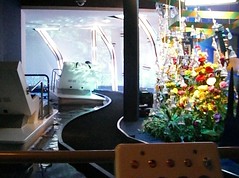
Germany's pavilion features a dark ride with recliner seats on boats. Unlike other dark rides I've been on, the intended visual focus is the ceiling. It's a very unique ride and a sometimes whimsical take on the expo's water theme.
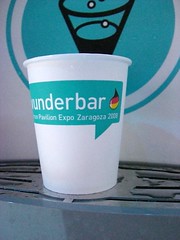
They even had free water at the end. After seeing exhibit after exhibit about water in Zargoza's 90º F heat, you can imagine how thirsty you get.
It surprises me that no other pavilion I've visited thus far has done this. Wunderbar!
Belgium recognizes the 50th anniversary of Expo 58 with models of the Atomium as well as this book in their gift shop.
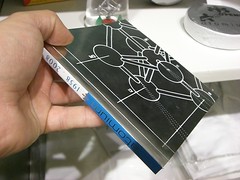
I wanted to buy one of the books, but was told they didn't know how much to charge and I should come back next week when they know.
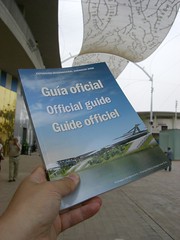
On a better note, I discovered where to buy the official guidebook. At most expositions, the guidebooks are front and center in the gift shops. At Expo 2008, they only seem to sell the book at off-site newsstands and bookshops and their rather well-stocked on-site bookshop. I was pleased to see they have all manner of books related to the issues of water and sustainable development.

Germany's pavilion features a dark ride with recliner seats on boats. Unlike other dark rides I've been on, the intended visual focus is the ceiling. It's a very unique ride and a sometimes whimsical take on the expo's water theme.

They even had free water at the end. After seeing exhibit after exhibit about water in Zargoza's 90º F heat, you can imagine how thirsty you get.
It surprises me that no other pavilion I've visited thus far has done this. Wunderbar!
Belgium recognizes the 50th anniversary of Expo 58 with models of the Atomium as well as this book in their gift shop.

I wanted to buy one of the books, but was told they didn't know how much to charge and I should come back next week when they know.

On a better note, I discovered where to buy the official guidebook. At most expositions, the guidebooks are front and center in the gift shops. At Expo 2008, they only seem to sell the book at off-site newsstands and bookshops and their rather well-stocked on-site bookshop. I was pleased to see they have all manner of books related to the issues of water and sustainable development.
22 June 2008
Expo 2008, Day 1
Today was the first day of my six day visit to Zaragoza, Spain's Expo 2008.
I am posting photos of my visit to ExpoMuseum's Expo 2008 Photos Page as I go along.
Today's highlights included a wonderful presentation at the Andalusia film that mixes video, lasers, and water to give a great sense of the region. This pavilion also demonstrates one of the things I most appreciate about good pavilion design in that it incorporates real people into the presentation. It makes it far more personal and compelling.

Austria also has a delightful pavilion that plays on the same humanistic theme. After proceeding up a ramp, you enter into a theater with a large inflated snow globe. It's actually only 1/4th of a globe reflected against a long mirrored wall. Inside the globe are fans and fake snow to give the illusion of a snow globe. A guest is selected by the pavilion staff as people are being seated. Moments later, the guest appears in the globe with a companion dancer dressed in traditional Austrian clothes. They dance a waltz for the audience. It was wonderful to watch the audience react.
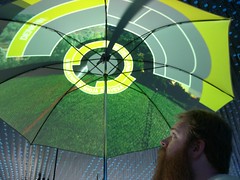
The Basque region of Spain used an interesting bit of technology where guests grasped suspended umbrellas with video displays projected on them. The handle of the umbrellas controls the images.
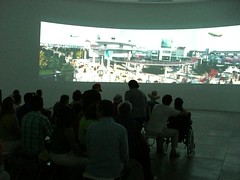
Not surprisingly, China's pavilion had on display its plans for Expo 2010.
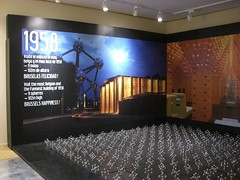
The Belgium pavilion, conversely, looked back 50 years to its own Expo 58.
I am posting photos of my visit to ExpoMuseum's Expo 2008 Photos Page as I go along.
Today's highlights included a wonderful presentation at the Andalusia film that mixes video, lasers, and water to give a great sense of the region. This pavilion also demonstrates one of the things I most appreciate about good pavilion design in that it incorporates real people into the presentation. It makes it far more personal and compelling.

Austria also has a delightful pavilion that plays on the same humanistic theme. After proceeding up a ramp, you enter into a theater with a large inflated snow globe. It's actually only 1/4th of a globe reflected against a long mirrored wall. Inside the globe are fans and fake snow to give the illusion of a snow globe. A guest is selected by the pavilion staff as people are being seated. Moments later, the guest appears in the globe with a companion dancer dressed in traditional Austrian clothes. They dance a waltz for the audience. It was wonderful to watch the audience react.

The Basque region of Spain used an interesting bit of technology where guests grasped suspended umbrellas with video displays projected on them. The handle of the umbrellas controls the images.

Not surprisingly, China's pavilion had on display its plans for Expo 2010.

The Belgium pavilion, conversely, looked back 50 years to its own Expo 58.
10 June 2008
Expo 2008 Opens in 4 Days
With Expo 2008's opening ceremonies just days away, things have clearly been busy in Zaragoza. Given Expo 2008's theme of water and sustainable development, it was ironic that the River Ebro flooded. From some of the photos I've seen posted on Flickr.com, it looks like it put some of the amphitheater underwater.
Last weekend, they had a test run with some folks on site and waiting in lines. I've found several videos on YouTube showing the sites, particularly the amazing views from the gondalas/telecabinas that run from Zaragoza's main railway station to the site.
Here's a representative video:
I leave for Europe this weekend and arrive in Zaragoza on the 21st. I'll be there a week and hope to have enough time to see everything, take tons of photos, and get some audio for ExpoMuseum's upcoming podcast.
Last weekend, they had a test run with some folks on site and waiting in lines. I've found several videos on YouTube showing the sites, particularly the amazing views from the gondalas/telecabinas that run from Zaragoza's main railway station to the site.
Here's a representative video:
I leave for Europe this weekend and arrive in Zaragoza on the 21st. I'll be there a week and hope to have enough time to see everything, take tons of photos, and get some audio for ExpoMuseum's upcoming podcast.
14 May 2008
Expo 2010 Pavilion Designs
I ran across a great run-down of Expo 2010 pavilion plans on a blog entry by a Pete in Australia:
http://petefords.blogspot.com/2008/03/expo-2010-update.html
Pete also has an interesting entry about his own background with world's fairs at:
http://petefords.blogspot.com/2007/11/expo-2010-here-i-come.html
http://petefords.blogspot.com/2008/03/expo-2010-update.html
Pete also has an interesting entry about his own background with world's fairs at:
http://petefords.blogspot.com/2007/11/expo-2010-here-i-come.html
22 April 2008
Expo x Expos
I received my copy of the BIE's Progression Magazine today and was
pleased to discover that an exhibition, Expo x Expos, will be
traveling around the world and visiting Madrid, Lisbon, Zaragoza (host of Expo 2008,
Brussels, Paris, New York, Chicago, San Francisco, Nagoya, Osaka, and
London. It is currently showing at the Triennale in Milan (which will host Expo 2015. Apparently,
in 2010, the exhibit will move from London, host of the first world's
fair to Shanghai, the host of Expo 2010.
I'm hoping to find out more information about this exhibition,
particularly its United States dates.
It would be wonderful if this exhibition could create renewed
awareness of the Bureau International des Expositions in the USA so
that we can re-join the organization.
At the very least, I can imagine it helping springboard San
Francisco's entry into the AVE, the Association of Cities and Regions
Hosting an International Exposition.
pleased to discover that an exhibition, Expo x Expos, will be
traveling around the world and visiting Madrid, Lisbon, Zaragoza (host of Expo 2008,
Brussels, Paris, New York, Chicago, San Francisco, Nagoya, Osaka, and
London. It is currently showing at the Triennale in Milan (which will host Expo 2015. Apparently,
in 2010, the exhibit will move from London, host of the first world's
fair to Shanghai, the host of Expo 2010.
I'm hoping to find out more information about this exhibition,
particularly its United States dates.
It would be wonderful if this exhibition could create renewed
awareness of the Bureau International des Expositions in the USA so
that we can re-join the organization.
At the very least, I can imagine it helping springboard San
Francisco's entry into the AVE, the Association of Cities and Regions
Hosting an International Exposition.
18 April 2008
The Expo Book, Chapter 3 Now Available

Chapter 3 of The Expo Book is now available to download from TheExpoBook.com. Chapters 1 and 2 are also still available.
Chapter 4 will soon be published by IPM Magazine.
Labels:
InPark Magazine,
IPM Magazine,
The Expo Book
U.S. Department of State Signs Letter of Intent for World Expo Shanghai 2010
The U.S. State Department has announced they've signed a letter of intent to create a U.S. Pavilion at Shanghai's Expo 2010:
http://www.state.gov/r/pa/prs/ps/2008/apr/103770.htm
It'll be interesting to see what happens since, unlike most other countries, government money can't be used in the planning, construction, or hosting of a U.S. Pavilion. From the original request for proposals last year, I understand that about 100 million dollars will need to be found from sponsoring organizations in order to make this happen.
With only two years to go before the opening of Expo 2010, that's a lot of work to get done in a very short period of time.
The planning for other similarly sized pavilions (such as the United Kingdoms' pavilion) have been well under way for a while, so it's going to be a challenge to have the paint dry and doors open by 01 May 2008.
http://www.state.gov/r/pa/prs/ps/2008/apr/103770.htm
It'll be interesting to see what happens since, unlike most other countries, government money can't be used in the planning, construction, or hosting of a U.S. Pavilion. From the original request for proposals last year, I understand that about 100 million dollars will need to be found from sponsoring organizations in order to make this happen.
With only two years to go before the opening of Expo 2010, that's a lot of work to get done in a very short period of time.
The planning for other similarly sized pavilions (such as the United Kingdoms' pavilion) have been well under way for a while, so it's going to be a challenge to have the paint dry and doors open by 01 May 2008.
Labels:
Expo 2010,
State Department,
United States Pavilion
09 April 2008
48 Hours in Zaragoza
Britain's The Independent published a great short video guide to Zaragoza, Spain and someone was kind enough to cut it into two parts and post it to YouTube.
With so many readers planning to attend Expo 2008, I thought I'd share it here.
Part 1:
Part 2:
With so many readers planning to attend Expo 2008, I thought I'd share it here.
Part 1:
Part 2:
08 April 2008
The Expo Book, Chapter 1 Now Available

Chapter 1 of The Expo Book is now available to download from TheExpoBook.com. Chapter 2 is also still available.
Chapter 3 will soon be published by IPM Magazine.
07 April 2008
1964-'65 New York State Pavilion Renovation
I remember the first time I visited Flushing Meadows, the site of New York's 1939-'40 and 1964-'65 World's Fairs, I was disappointed that the New York State Pavilion, designed by Philip Johnson and Richard Foster, was in such a sad state. That was 1989. When I last visited, in 2006, it was much, much worse. It looks like things might change soon, at least for the big map floor:
http://www.nytimes.com/2008/04/07/nyregion/07map.html
I'd love to see the whole structure renovated. There was talk, a few years ago, of enclosing the original tent area and turning it into an air and space museum.
Incidentally, I do have to take issue with the project's web site when it claims "The New York World’s Fair was one of the last international expositions. No longer relevant as a way to bring the world to the public, the Fair as event and construction is obsolete."
Since the last New York World's Fair closed in 1965, there have been sixteen world's fairs with one opening in a matter of weeks (Expo 2008), and three more in the next eight years (Expo 2010, Expo 2012, and Expo 2015).
http://www.nytimes.com/2008/04/07/nyregion/07map.html
I'd love to see the whole structure renovated. There was talk, a few years ago, of enclosing the original tent area and turning it into an air and space museum.
Incidentally, I do have to take issue with the project's web site when it claims "The New York World’s Fair was one of the last international expositions. No longer relevant as a way to bring the world to the public, the Fair as event and construction is obsolete."
Since the last New York World's Fair closed in 1965, there have been sixteen world's fairs with one opening in a matter of weeks (Expo 2008), and three more in the next eight years (Expo 2010, Expo 2012, and Expo 2015).
04 April 2008
International Exposition Identity and Branding
In January 2008, I was invited to guest lecture a graphic design class at Cal Poly Pomona. The class project is to study the history of Olympic games identity. Each student then creates a branding strategy for an Olympic bid.
I spoke about the history of international expositions and their identity and branding strategies since 1958.
Here were the supporting visuals (with no audio):
I spoke about the history of international expositions and their identity and branding strategies since 1958.
Here were the supporting visuals (with no audio):
Labels:
branding,
design,
graphics,
identity,
International Exposition,
logo,
world's fair
31 March 2008
Milan, Italy to Host Expo 2015
It was announced in Paris today that Milan, Italy will host Expo 2015
under the theme "Feeding the Planet / Energy for Life." It was
selected by the Bureau International des Expositions (BIE) over rival
city Izmir, Turkey.
under the theme "Feeding the Planet / Energy for Life." It was
selected by the Bureau International des Expositions (BIE) over rival
city Izmir, Turkey.
26 February 2008
The Expo Book

I'm fortunate to have been asked to contribute my design skills to a great project, The Expo Book. The full title is The Expo Book: A Guide to the Planning, Organization, Design & Operation of World Expositions.
Written by Gordon Linden and Paul Creighton, the book is being published in six installments in InPark Magazine with the help of Editor Judith Rubin.
Labels:
Gordon Linden,
Judith Rubin,
Paul Creighton,
The Expo Book
15 February 2008
The Lure of Towers at World's Fairs
In my early days as a student of world's fairs, I was fascinated by the towers created at world's fairs. As a child, tall structures really have a greater power than perhaps they do as an adult. In architecture school, an interest in skyscrapers over more "artsy" buildings is looked down upon by many professors.
In the most recent expos, there haven't been as much a reliance on tall towers as a draw, but I think they were disfavored in more recent decades as being distractions from the more serious nature of world's fairs and can take away from the theme's goals.
I think they still have a power outside their own physical existence. 1889's Eiffel Tower, 1962's Space Needle, and even 1982's Sunsphere have a draw. San Antonio's Tower of the Americas from Hemisfair '68 just reopened with great fanfare.
I think the towers can provide a certain level of initial excitement about an exposition. It acts as an exclamation point to send the message that what's going on underneath is important.
For that reason, I was happy to hear that Expo 2010 will have a tower. Theirs will have, if you'll pardon the expression, a twist. They're using an existing chimney on the site to create an observation tower. To get to the top, visitors will ride roller-coaster-style cars.

By reusing the tower, they can illustrate the benefits of reusing existing structures instead of tearing them down to rebuild, thus fitting with the environmental aspects of the "Better City, Better Life" theme.
I know I can't wait to go up it in two years. I just wonder what the ride back down will be like!
In the most recent expos, there haven't been as much a reliance on tall towers as a draw, but I think they were disfavored in more recent decades as being distractions from the more serious nature of world's fairs and can take away from the theme's goals.
I think they still have a power outside their own physical existence. 1889's Eiffel Tower, 1962's Space Needle, and even 1982's Sunsphere have a draw. San Antonio's Tower of the Americas from Hemisfair '68 just reopened with great fanfare.
I think the towers can provide a certain level of initial excitement about an exposition. It acts as an exclamation point to send the message that what's going on underneath is important.
For that reason, I was happy to hear that Expo 2010 will have a tower. Theirs will have, if you'll pardon the expression, a twist. They're using an existing chimney on the site to create an observation tower. To get to the top, visitors will ride roller-coaster-style cars.

By reusing the tower, they can illustrate the benefits of reusing existing structures instead of tearing them down to rebuild, thus fitting with the environmental aspects of the "Better City, Better Life" theme.
I know I can't wait to go up it in two years. I just wonder what the ride back down will be like!
11 February 2008
The Expo '67 Site: 40 Years Later
I love visiting the sites of former world's fairs and finding little artifacts here and there.
There aren't many like me that could get excited at finding evidence of the foundation for the Australian Pavilion at site of the 1982 World's Fair in Knoxville, but I know I'm not alone.
This wonderful collection of photos documents the same views of Montreal's Expo '67 site in 1967 and 2007.
Subscribe to:
Posts (Atom)
